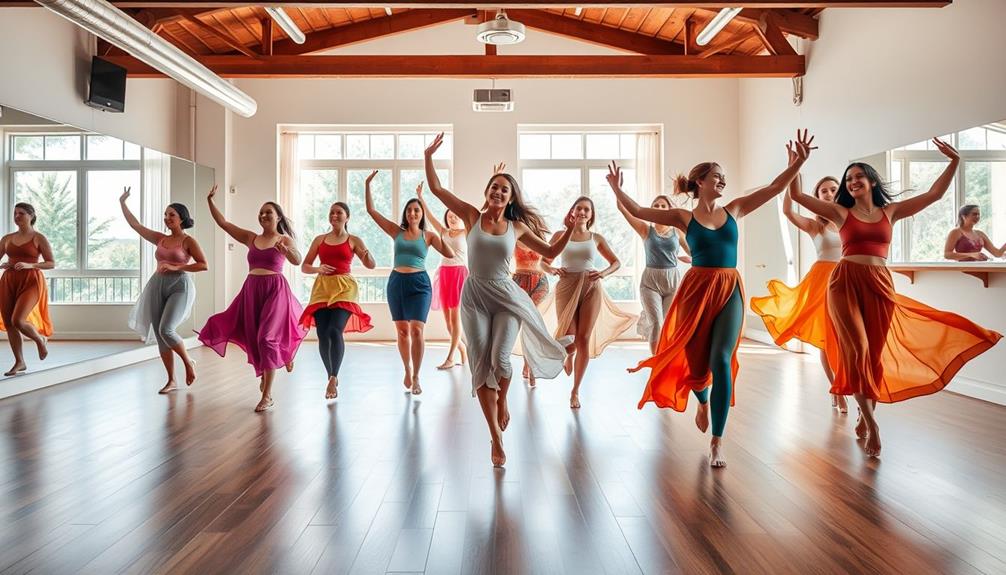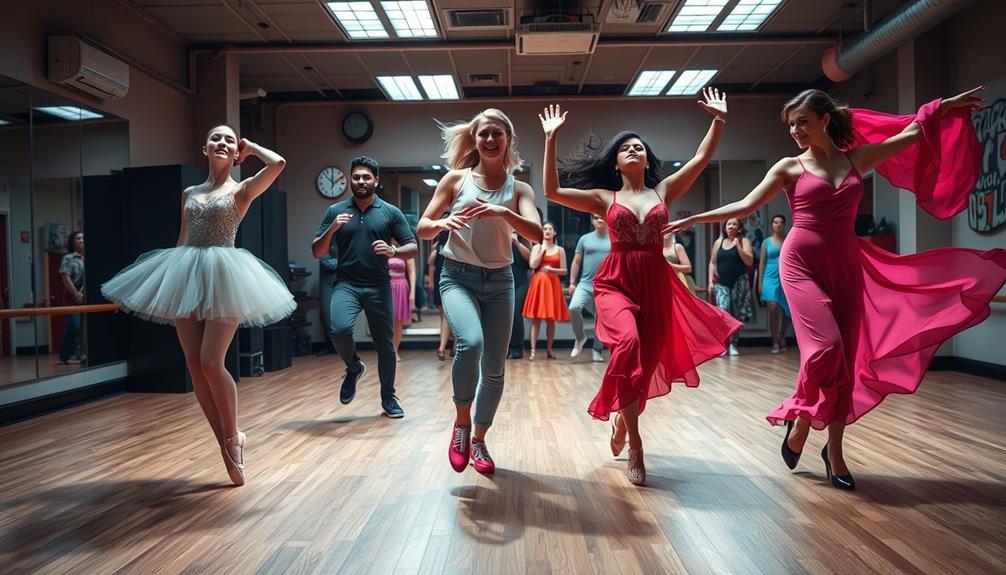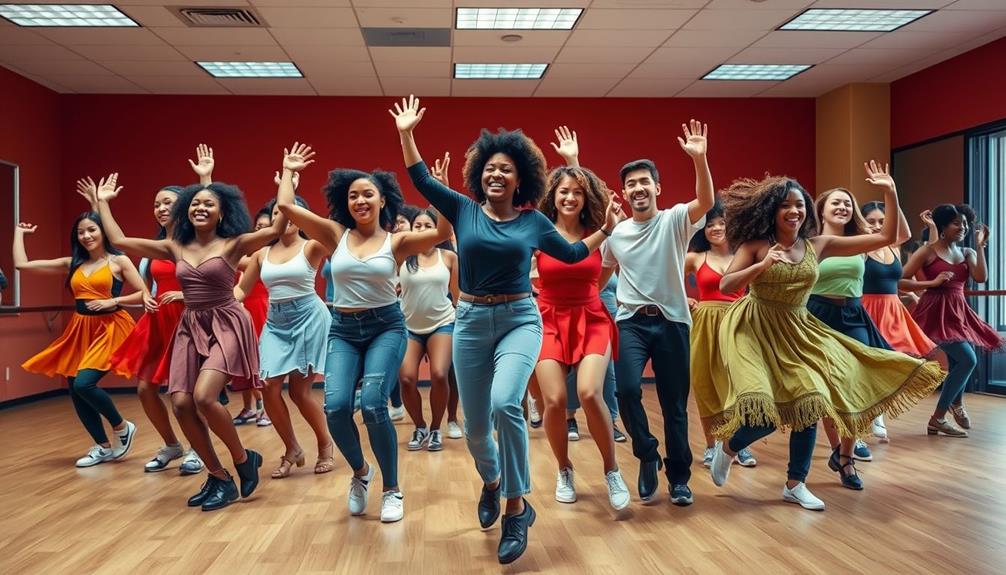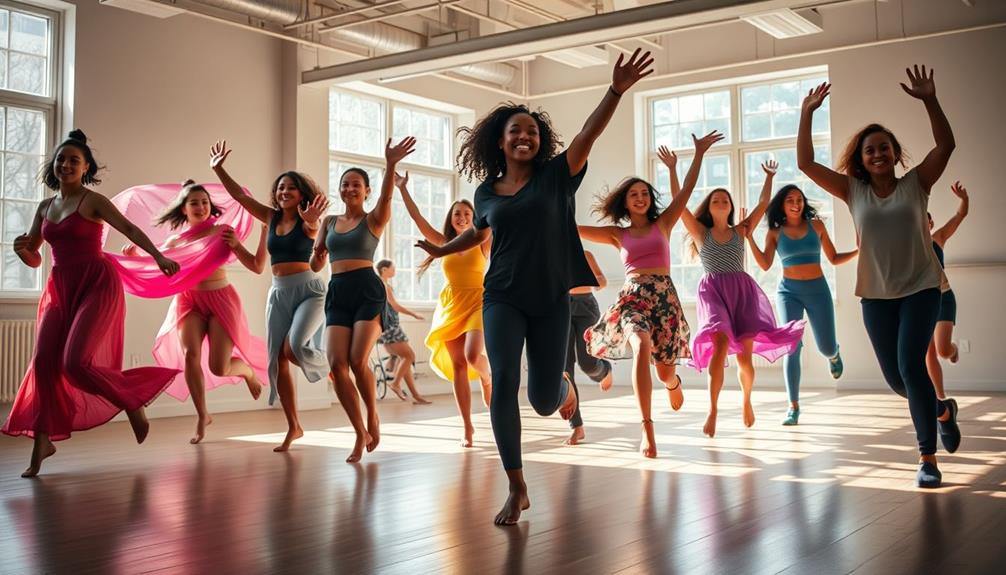Dancing's therapeutic benefits are vast and transformative. It boosts your cardiovascular health, strengthens your bones, and enhances coordination. Mentally, it lifts your mood by releasing endorphins, helping to alleviate anxiety and depression. Whether you choose ballet, salsa, or hip-hop, you'll find enjoyment and a sense of belonging in community classes. Plus, dance movement therapy provides unique emotional healing through techniques like body awareness and mirroring, making it effective for various mental health challenges. If you're curious about how to start your dancing journey or explore its deeper benefits, there's plenty more to discover. In addition to the individual therapeutic benefits of dancing, group dance activities can also promote social connections and a sense of camaraderie, which are crucial for overall well-being. Moreover, exploring other forms of creative expression, such as group drumming benefits, can further enhance the therapeutic experience by providing an outlet for self-expression and stress relief in a communal setting. Engaging in these activities can lead to a holistic approach to health and wellness, addressing both physical and emotional needs.
Key Takeaways
- Dancing improves cardiovascular health, boosts lung function, aids weight management, and enhances coordination, reducing fall risks in older adults.
- It releases endorphins, elevating mood and alleviating anxiety and depression, contributing to better mental health.
- Dance Movement Therapy (DMT) utilizes movement to promote emotional and cognitive healing, recognized by the American Dance Therapy Association.
- DMT techniques, like mirroring and body awareness, enhance self-awareness, emotional regulation, and communication skills.
- Engaging in dance fosters community connections, accountability, and support, which are beneficial for psychological health and overall well-being.
Health Benefits of Dancing
Dancing offers a multitude of health benefits that can greatly enhance your overall well-being. When you dance, you're not just having fun; you're also improving your cardiovascular health by boosting heart and lung function. This contributes to better physical fitness and endurance, helping you feel more energetic throughout the day.
Regular dance practice aids in weight management and strengthens your bones, making it an excellent choice for maintaining a healthy body composition.
Moreover, dance enhances your coordination and balance, which are essential for motor fitness. This can greatly reduce your risk of falls, especially as you age.
But the benefits don't stop at physical health. Engaging in dance releases endorphins, which can elevate your mood and alleviate feelings of anxiety and depression. It's a natural way to improve your mental health.
For children and adolescents, dance offers considerable developmental benefits, fostering both physical health and psychological well-being.
Incorporating dance movement therapy into your routine can further amplify these advantages, providing a holistic approach to health.
Getting Started With Dance

If you've been thinking about diving into the world of dance, now's the perfect time to start! Begin by choosing a dance style that excites you, like ballet, hip-hop, or salsa. Look for local dance classes at community centers or explore online platforms that cater to beginners.
When deciding on classes, consider whether you prefer the camaraderie of group settings or the focused attention of private lessons. Both options can provide a comfortable learning environment.
Before you hit the dance floor, don't skip your warm-up exercises; they're essential for preparing your body and minimizing injury risk. Hydration is also key during your sessions.
Dance is accessible for all ages and fitness levels, requiring minimal equipment, though some styles might need specific shoes.
Here's a quick overview of the benefits of starting dance:
| Benefit | Description |
|---|---|
| Physical Fitness | Engages your whole body for exercise |
| Mental Well-Being | Boosts mood and reduces stress |
| Coordination & Balance | Improves body awareness and stability |
| Social Interaction | Connects you with others in classes |
| Accessible Anywhere | Can be practiced indoors or outdoors |
Embrace the joy of dance and reap its many rewards!
Types of Dance Styles

Dance offers a vibrant array of styles, each with its own unique flair and benefits. If you're looking to improve your health while having fun, consider exploring these diverse dance forms. Engaging in dance can contribute to a source of inspiration for adopting a healthier lifestyle, as it promotes both physical fitness and emotional well-being.
Ballet emphasizes strength and flexibility, helping you develop discipline and grace through structured movements set to classical music.
If you prefer social interaction, ballroom dancing is perfect for you. Styles like waltz, tango, and foxtrot enhance coordination and teamwork, making it a great way to engage with others.
For those craving self-expression, hip-hop provides an energetic outlet. This urban style encourages creativity through dynamic movements and beats, letting you showcase your personality.
If you enjoy lively rhythms, try salsa. This partner dance, infused with Caribbean and Latin influences, not only fosters connection but also gives you a fantastic cardiovascular workout.
Lastly, tap dancing focuses on rhythm and sound. As you wear shoes equipped with metal taps, you'll create percussive sounds, enhancing your musicality and timing.
Each dance style brings unique health benefits, making it easy to find one that resonates with you.
Choosing Your Dance Style

Finding the right dance style can be an exciting journey that opens doors to improved fitness and self-expression. As you explore your options, reflect on your fitness improvement goals. Do you want to enhance cardiovascular health or increase flexibility? Different styles emphasize various physical benefits, so it's crucial to match your interests with the right dance moves.
Engaging in dance can also promote emotional well-being and reduce stress, making it a holistic approach to health and happiness. Additionally, dancing with others can foster social skills through interaction, similar to the way play enhances social interactions.
Here are some factors to reflect on:
- Fast-paced options like hip-hop or salsa boost aerobic fitness.
- Slower styles such as ballet or ballroom focus on strength and flexibility.
- Group classes foster social connections, while private lessons provide personalized instruction.
- Explore diverse styles like tap for rhythm and contemporary for creative expression.
- Many styles adapt to all ages and fitness levels, ensuring accessibility for everyone.
Choosing the right dance style can notably impact your quality of life among various physical and mental aspects.
Whether you dance for fun or fitness, the benefits are boundless. Embrace the journey to find what resonates with you, and let the joy of dance enhance your well-being!
Tips for Dancing Success

To dance successfully, always start with warm-up and stretching exercises to prepare your body and reduce the risk of injury.
Establishing a consistent practice routine will help you build skills and improve your confidence on the dance floor.
Warm-Up and Stretching
A proper warm-up routine is vital for anyone looking to excel in dance. It prepares your muscles and joints, reduces the risk of injury, and enhances your overall performance.
Incorporating techniques similar to those used in aromatherapy practices can also promote relaxation and focus, setting a positive mindset for your dance session. A 5-10 minute warm-up can greatly improve your coordination and balance, which are essential for executing dance steps successfully.
Here are some tips for effective warm-up and stretching:
- Start with dynamic stretches: Arm circles and leg swings increase blood flow and flexibility.
- Incorporate light cardio: Activities like jogging in place elevate your heart rate and warm up your body.
- Focus on key muscle groups: Target areas like your legs, arms, and back for a thorough warm-up.
- Stay hydrated: Drink water before and during your warm-up to maintain ideal muscle function.
- Finish with static stretching: Post-dance, static stretches help lengthen muscles and improve flexibility, aiding recovery and reducing soreness.
Consistent Practice Routine
After warming up and stretching, establishing a consistent practice routine can greatly elevate your dancing skills. Aim for at least 30 minutes of regular dance sessions three to five times a week. This commitment enhances muscle memory and coordination, key components for mastering complex moves.
Incorporate various dance styles to keep things fresh and engage different muscle groups, which not only boosts fitness but also enhances enjoyment. Additionally, just like yoga can help with physical alignment, incorporating yoga for back pain management may improve your overall flexibility and posture, further benefiting your dance practice.
Set specific goals, like mastering a particular move or increasing your endurance. This focus helps maintain motivation and allows you to track your progress effectively. Remember to include warm-up and cool-down exercises in each session to prevent injuries and improve flexibility, ensuring a safe practice routine.
Consider joining a dance class or community group. These environments foster accountability and provide social connections, both of which are beneficial for your psychological health. Plus, experienced instructors can offer guidance and support, enhancing your overall dance interventions.
Dance Movement Therapy Explained

Dance Movement Therapy (DMT) uses movement as a therapeutic tool to boost your emotional, cognitive, and physical well-being.
It aligns with holistic lifestyle approaches that can enhance mental health, similar to how mindful eating practices improve overall well-being.
You'll experience various techniques like mirroring and non-verbal metaphors that not only promote healing but also enhance your mental health.
As you explore DMT, you might find it effectively reduces anxiety and depression while improving your overall quality of life.
Definition of Dance Movement Therapy
At its core, Dance Movement Therapy (DMT) is the psychotherapeutic use of movement to enhance your emotional, cognitive, and physical well-being.
Originating in the 1940s, DMT integrates dance and movement as a means of healing, focusing on the holistic connection between your mind and body.
Recognized by the American Dance Therapy Association (ADTA), DMT employs a variety of techniques to facilitate this healing process.
This approach can be particularly beneficial for individuals who've experienced the impacts of narcissistic abuse, as it offers a safe space for emotional release and self-exploration.
Here are some key aspects of DMT:
- It promotes emotional expression and communication through movement.
- A dance movement therapist guides you in exploring your feelings and experiences.
- DMT effectively addresses psychological issues like anxiety, depression, and PTSD.
- Research shows improvements in cognitive skills and quality of life.
- It fosters better interpersonal relationships and social interactions.
Techniques Used in DMT
Understanding the various techniques used in Dance Movement Therapy (DMT) can illuminate how this approach fosters emotional healing and personal growth. One key technique is mirroring, where therapists reflect your movements, enhancing your self-awareness and communication skills. This process allows you to see your emotions expressed through dance, making it easier to understand your feelings.
Additionally, DMT often incorporates elements of body awareness techniques, which may lead to improved emotional regulation and trauma release.
Another essential aspect involves non-verbal metaphors, which help you convey complex emotions and ideas through movement rather than words. This facilitates deeper emotional exploration, allowing you to connect with your feelings on a profound level.
Movement analysis is also critical; it assesses your physical expressions and behaviors, guiding therapeutic interventions based on the patterns observed.
Introspection techniques encourage you to reflect on your movements and feelings, promoting emotional processing and personal insight.
Additionally, group dynamics create a supportive environment, fostering cohesion and trust among participants. This shared movement experience enhances interpersonal learning and empowerment, as you navigate your emotions alongside others.
Through these techniques, DMT offers a unique pathway to healing, transforming your relationship with yourself and others through the power of dance.
Benefits for Mental Health
While exploring the therapeutic landscape, you'll find that Dance Movement Therapy (DMT) offers substantial benefits for mental health. By integrating movement as a form of expression, DMT effectively addresses emotional, cognitive, and physical well-being.
This therapy can lead to significant improvements in psychological health outcomes, including reductions in anxiety and depression. Research indicates a medium effect size of d = 0.60, demonstrating its effectiveness across various studies. Additionally, those with complex emotional experiences, such as individuals with BPD push-pull dynamics, can find DMT particularly beneficial in managing their emotional responses.
Here are some key benefits you can expect from DMT:
- Decreased symptoms of anxiety and depression
- Enhanced quality of life
- Improved interpersonal skills
- Cognitive skill development
- Long-term mental health benefits, even after 22 weeks of intervention
DMT is especially beneficial for individuals with schizophrenia, showing a remarkable 30.88% improvement in negative symptoms.
As the body of research continues to grow, with a notable increase in studies, DMT is gaining recognition as a valuable therapeutic approach. Ultimately, engaging in DMT not only enriches your mental health but also provides a supportive complement to traditional therapy methods, fostering a holistic path toward wellness.
Frequently Asked Questions
What Are the Therapeutic Effects of Dance?
Dance offers you therapeutic effects by boosting your mood, enhancing self-esteem, and reducing anxiety. It promotes social connections, improves cognitive function, and lowers stress levels, ultimately contributing to your overall mental and emotional well-being.
What Are the 4 Mental Benefits of Dancing?
When you dance, it's like your brain throws a party! You boost your mood, sharpen your memory, reduce stress levels, and connect with others, creating joy and confidence that make you feel unstoppable on the dance floor!
Why Is Dance a Good Form of Therapy?
Dance is a great therapy because it lifts your mood, connects you with others, reduces stress, and sharpens your mind. You'll feel more energized, engaged, and supported, making it an enjoyable way to boost your well-being.
What Are the Three Main Purposes of Dance Therapy?
You might think dance therapy's just about moving to music, but its main purposes are enhancing emotional expression, improving physical health, and fostering social connections. Who knew dancing could be so serious yet so fun?
Conclusion
Incorporating dance into your life isn't just about moving to the beat; it's a vibrant key that opens up a world of health benefits and emotional healing. Whether you're twirling like a dervish or simply swaying to your favorite tune, you're investing in your well-being. So lace up those dancing shoes and let the rhythm guide you. Remember, every step you take brings you closer to joy, health, and a deeper connection with yourself. Dance your heart out!










